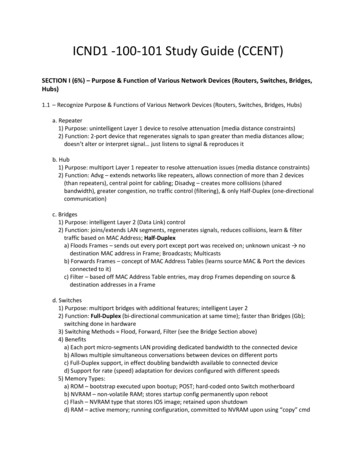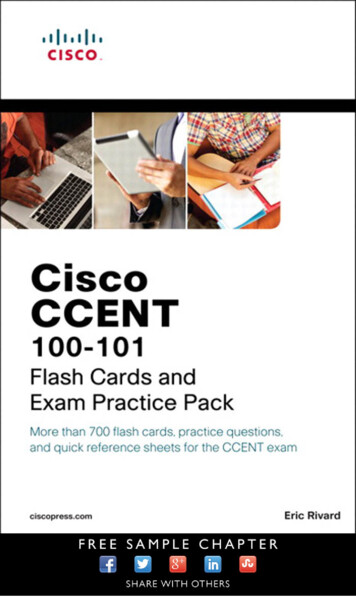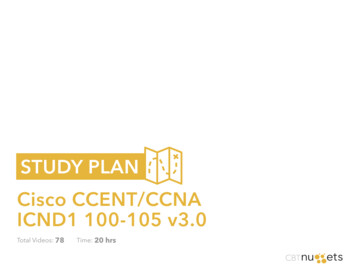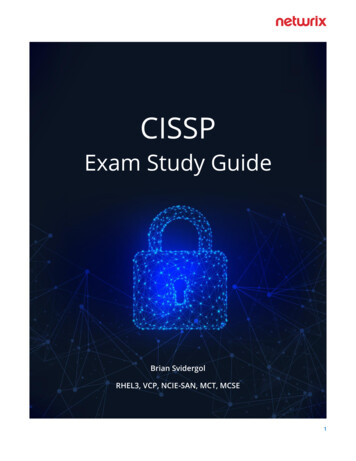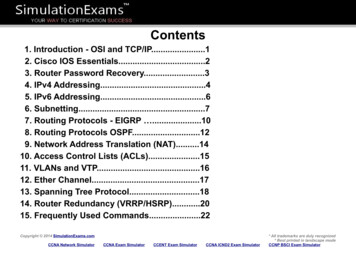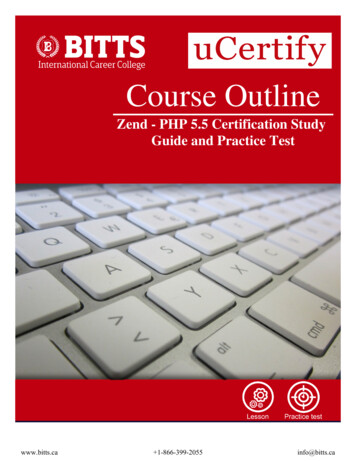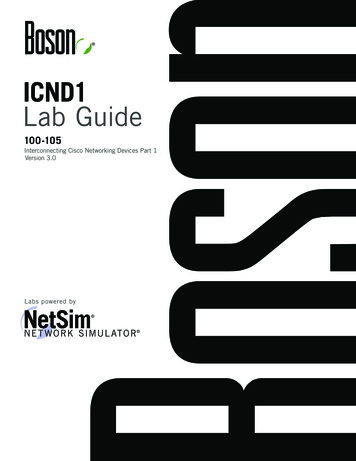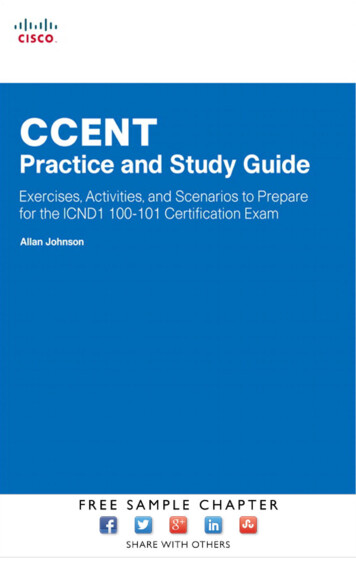
Transcription
CCENT Practice and Study Guide:Exercises, Activities, and Scenariosto Prepare for the ICND1/CCENTCertification ExamAllan JohnsonCisco Press800 East 96th StreetIndianapolis, Indiana 46240 USA
iiCCENT Practice and Study GuideCCENT Practice and Study Guide: Exercises,Activities, and Scenarios to Prepare for theICND1/CCENT Certification ExamPublisherPaul BogerAllan JohnsonBusiness Operation ManagerCisco PressJan CornelssenCopyright 2014 Cisco Systems, Inc.Cisco Press logo is a trademark of Cisco Systems, Inc.Published by:Cisco Press800 East 96th StreetIndianapolis, IN 46240 USAAll rights reserved. No part of this book may be reproduced or transmitted inany form or by any means, electronic or mechanical, including photocopying,recording, or by any information storage and retrieval system, without writtenpermission from the publisher, except for the inclusion of brief quotations in areview.Printed in the United States of AmericaFirst Printing December 2013Library of Congress Control Number: 2013953354ISBN-13: 978-1-58713-345-9ISBN-10: 1-58713-345-8Associate PublisherDave DusthimerExecutive EditorMary Beth RayProduction ManagerSandra SchroederSenior Development EditorChristopher ClevelandProject EditorMandie FrankCopy EditorKeith ClineTechnical EditorSteve StilesEditorial AssistantVanessa EvansBook DesignerMark ShirarCompositionTrina WurstProofreaderMegan Wade-Taxter
iiiTrademark AcknowledgmentsAll terms mentioned in this book that are known to be trademarks or service marks have beenappropriately capitalized. Cisco Press or Cisco Systems, Inc., cannot attest to the accuracy ofthis information. Use of a term in this book should not be regarded as affecting the validity ofany trademark or service mark.Warning and DisclaimerThis book is designed to provide information about networking. Every effort has been made tomake this book as complete and as accurate as possible, but no warranty or fitness is implied.The information is provided on an “as is” basis. The authors, Cisco Press, and Cisco Systems,Inc. shall have neither liability nor responsibility to any person or entity with respect to anyloss or damages arising from the information contained in this book or from the use of thediscs or programs that may accompany it.The opinions expressed in this book belong to the author and are not necessarily those ofCisco Systems, Inc.Corporate and Government SalesThe publisher offers excellent discounts on this book when ordered in quantity for bulkpurchases or special sales, which may include electronic versions and/or custom covers andcontent particular to your business, training goals, marketing focus, and branding interests.For more information, please contact:U.S. Corporate and Government Sales1-800-382-3419 corpsales@pearsontechgroup.comFor sales outside the United States please contact:International Sales international@pearsoned.comFeedback InformationAt Cisco Press, our goal is to create in-depth technical books of the highest quality and value.Each book is crafted with care and precision, undergoing rigorous development that involvesthe unique expertise of members from the professional technical community.Readers’ feedback is a natural continuation of this process. If you have any commentsregarding how we could improve the quality of this book, or otherwise alter it to better suityour needs, you can contact us through email at feedback@ciscopress.com. Please make sureto include the book title and ISBN in your message.We greatly appreciate your assistance.8
ivCCENT Practice and Study GuideAbout the AuthorAllan Johnson entered the academic world in 1999 after 10 years as a business owner/operator to dedicate his efforts to his passion for teaching. He holds both an MBA and anM.Ed in occupational training and development. He is an information technology instructorat Del Mar College in Corpus Christi, Texas. In 2003, Allan began to commit much of histime and energy to the CCNA Instructional Support Team, providing services to NetworkingAcademy instructors worldwide and creating training materials. He now works full time forCisco Networking Academy as a learning systems developer.About the Technical ReviewerSteve Stiles is a Cisco Network Academy instructor for Rhodes State College and a Ciscocertified instructor trainer having earned CCNA Security- and CCNP-level certifications. Hewas the recipient of the 2012 Outstanding Teacher of the Year award by the Ohio Associationof Two-Year Colleges and co-recipient for the Outstanding Faculty of the Year award atRhodes State College.
vDedicationFor my wife, Becky. Without the sacrifices you made during the project, this work wouldnot have come to fruition. Thank you providing me the comfort and resting place only youcan give.
viCCENT Practice and Study GuideAcknowledgmentsWhen I began to think of whom I would like to have as a technical editor for this work, SteveStiles immediately came to mind. With his instructor and industry background, as well as hisexcellent work building activities for the new Cisco Networking Academy curriculum, hewas an obvious choice. Thankfully, when Mary Beth Ray contacted him, he was willing andable to do the arduous review work necessary to make sure that you get a book that is bothtechnically accurate and unambiguous.The Cisco Network Academy authors for the online curriculum and series of CompanionGuides take the reader deeper, past the CCENT exam topics, with the ultimate goal of notonly preparing the student for CCENT certification, but also for more advanced college-leveltechnology courses and degrees, as well. Thank you, especially to Amy Gerrie and her team ofauthors—Rick Graziani, Wayne Lewis, and Bob Vachon—for their excellent treatment of thematerial; it is reflected throughout this book.Mary Beth Rey, executive editor, you amaze me with your ability to juggle multiple projectsat once, steering each from beginning to end. I can always count on you to make the toughdecisions.This is my fifth project with Christopher Cleveland as development editor. His dedication toperfection pays dividends in countless, unseen ways. Thank you again, Chris, for providingme with much-needed guidance and support. This book could not be a reality without yourpersistence.
viiContents at a GlancePart I: Introduction to NetworksChapter 1Exploring the Network1Chapter 2Configuring a Network Operating SystemChapter 3Network Protocols and CommunicationsChapter 4Network AccessChapter 5EthernetChapter 6Network LayerChapter 7Transport LayerChapter 8IP AddressingChapter 9Subnetting IP NetworksChapter 10Application LayerChapter 11It’s a Network131929415365718597105Part II: Routing and Switching EssentialsChapter 12Introduction to Switched Networks117Chapter 13Basic Switching Concepts and ConfigurationChapter 14VLANsChapter 15Routing ConceptsChapter 16Inter-VLAN RoutingChapter 17Static RoutingChapter 18Routing DynamicallyChapter 19Single-Area OSPFChapter 20Access Control ListsChapter 21DHCPChapter 22Network Address Translation for IPv4135149171183197221237255265125
viiiCCENT Practice and Study GuideContentsPart I: Introduction to NetworksCHAPTER 1Exploring the Network 1Globally Connected 1Vocabulary Exercise: Matching 2Completion Exercise 3LANs, WANs, and the Internet3Completion Exercise 3Classify and Identify Network ComponentsCompare LANs and WANs 6Vocabulary Exercise: Matching 7The Network as a Platform58Classify Network Architecture Requirements8The Changing Network Environment 10Completion Exercise 10Network Security Terminology 11CHAPTER 2Configuring a Network Operating System 13IOS Bootcamp 13Completion Exercise 13Accessing a Cisco IOS Device 14Navigating the IOS Matching Exercise 15Basic Device Configuration 16Applying a Basic Configuration 16CHAPTER 3Network Protocols and Communications 19Rules of Communication 19Vocabulary Exercise: Matching 20Network Protocols and Standards 21Protocol Definitions: Matching 21Mapping the Protocols of the TCP/IP Suite 22Explore the Purpose of Standards Organizations 22OSI Reference Model Layers: Matching 24TCP/IP Model Layers: Matching 24Mapping the Layers of the OSI and TCP/IP Models 25Moving Data in the Network 26Data Encapsulation and the PDUs 26The Role of Addressing in Network Communications 27CHAPTER 4Network Access 29Physical Layer Protocols 29Completion Exercise 29Vocabulary Exercise: Matching 31
ixNetwork Media 32Copper Cabling Completion Exercise 32Compare UTP, STP, and Coaxial Characteristics 32UTP Cabling Completion Exercise 33UTP Cable Pinouts 34Fiber-Optic Cabling Completion Exercise 34Compare Single-Mode and Multimode Fiber 35Wireless Media Completion Exercise 36Data Link Layer Protocols 37The Sublayers of the Data Link Layer 37Label the Generic Frame Fields 37Identify the Data Link Layer Standards OrganizationMedia Access Control38Topologies and Access Methods Completion ExerciseLabel the Ethernet Frame Fields 39Label the PPP Frame Fields 40Label the 802.11 Wireless Frame Fields 40CHAPTER 5Ethernet373841Ethernet Protocol 41Ethernet Operation Completion Exercise 41Identify the Ethernet Frame Attributes: Matching 42Comparing Decimal, Binary, and Hexadecimal Digits 43Address Resolution Protocol 43Completion Exercise 43Identify the MAC and IP Addresses44LAN Switches 45Building the MAC Address Table 45Switching Concepts Completion Exercise 46Comparing Switch Forwarding Methods 47Forward the Frame 47Layer 3 Switching Concepts Completion ExerciseLayer 3 Switch Configuration 51CHAPTER 6Network Layer5053Network Layer Protocols53The Processes of the Network Layer 53Characteristics of the IP Protocol 53Fields of the IPv4 Packet: Matching 55Fields of the IPv6 Packet: Matching 55Routing 56How a Host Routes Packets Completion ExerciseRouting Table Entry: Matching 5856
xCCENT Practice and Study GuideRouters 58Identify Router Components 58Router Boot Process Exercise 59Interpreting the show version Command ExerciseConfiguring a Cisco Router60Basic Router Configuration Exercise 60Applying a Basic Configuration 62Verifying Basic Router ConfigurationCHAPTER 7Transport Layer606365Transport Layer Protocols65Transportation of Data Completion ExerciseIntroducing TCP and UDP 6665TCP and UDP 66TCP Communication 67UDP Communication 69TCP or UDP, That Is the QuestionCHAPTER 8IP Addressing6971IPv4 Network Addresses71IPv4 Address Structure 71IPv4 Subnet Mask 72The Last Nonzero Octet 73ANDing to Determine the Network Address 73IPv4 Unicast, Broadcast, and Multicast 74Types of IPv4 Addresses 74IPv6 Network Addresses75Representing IPv6 Addresses 76Identify IPv6 Address Types 77IPv6 Unicast Addresses 80The 3-1-4 Rule 80Static Configuration of Global Unicast Addressing 81Dynamic Configuration of Global Unicast Addressing 81IPv6 Multicast Addresses 82Connectivity Verification 83ICMP Message TypesTesting the Path 83CHAPTER 983Subnetting IP NetworksSubnetting an IPv4 Network8585Subnetting in Four Steps 85Subnetting Example 85Determine How Many Bits to Borrow 85Determine the New Subnet Mask 86Determine the Subnet Multiplier 86List the Subnets, Host Ranges, and Broadcast Addresses87
xiSubnetting Scenario 1Subnetting Scenario 2Subnetting Scenario 3878788VLSM Addressing Schemes 88VLSM Review 89VLSM Addressing Design ExercisesExercise 1 91Exercise 2 92Exercise 3 93Exercise 4 9390Design Considerations for IPv6 94Subnetting an IPv6 Network 95IPv6 Subnetting Practice 95IPv6 Subnetting Scenario 1 95IPv6 Subnetting Scenario 2 96IPv6 Subnetting Scenario 3 96CHAPTER 10 Application Layer97Application Layer Protocols 97OSI and TCP/IP Model Comparison 97Application and Presentation Protocols and Standards 98How Application Protocols Interact with End-User ApplicationsWell-Known Application Layer Protocols and Services 99Web and Mail Services 99IP Addressing Services 100File Sharing Services 102The Message Heard Around the World 103CHAPTER 11 It’s a NetworkCreate and Grow105105Devices in a Small Network 105Protocols in a Small Network 106Growing to Larger Networks 107Keeping the Network Safe107Network Device Security Measures 107Vulnerabilities and Network Attacks 108Mitigating Network Attacks 109Securing Devices 110Basic Network Performance 110Using the ping CommandTracing a Route 111show Commands 112111Managing IOS Configuration Files 114Integrated Routing Services 11698
xiiCCENT Practice and Study GuidePart II: Routing and Switching EssentialsCHAPTER 12 Introduction to Switched NetworksLAN Design117117LAN Design Principles 117Selecting Switch Hardware 119The Switched Environment120Frame Forwarding Methods and TerminologyBuilding the MAC Address Table 120Collision and Broadcast Domains 122CHAPTER 13 Basic Switching Concepts and ConfigurationBasic Switch Configuration120125125Switch Boot Sequence 125Half-Duplex, Full-Duplex, and Auto-MDIX 125Configure a Switch with Initial Settings 126Basic Configuration Tasks 127Applying a Basic Configuration 127Verifying Basic Switch Configuration 129Switch Security: Management and Implementation 129Configuring SSH 129Common Security Attacks 131Configuring Port Security 132Configuring NTP 134NTP Commands 134CHAPTER 14 VLANs 135VLAN Segmentation135Overview of VLANs 135VLANs in a Multiswitched EnvironmentVLAN Implementations137VLAN Configuration Exercise 137Practice VLAN Configuration 141VLAN Trunk Configuration Exercise 141Practice Trunk Configuration 142Dynamic Trunking Protocol 143Troubleshoot VLANs and Trunks 144VLAN Security and Design146Switch Spoofing Attack 146Double-Tagging Attack 147PVLAN Edge 147CHAPTER 15 Routing Concepts149Initial Configuration of a Router149Functions of a Router 149External Router Features 152136
xiiiTopology and Addressing Documentation 154Configure and Verify Dual-Stack IPv4 and IPv6 AddressingRouting Decisions161Path Determination 162Concept of Administrative Distance ExerciseSwitching Packets Between Networks 164Router Operation164165Analyze the Routing Table 165Directly Connected, Static, and Dynamic RoutesCHAPTER 16 Inter-VLAN Routing167171Inter-VLAN Routing Configuration 171Types of Inter-VLAN Routing 171Configuring Inter-VLAN Routing 172Troubleshoot Inter-VLAN Routing 174Inter-VLAN Troubleshooting Scenarios174Layer 3 Switching 176Layer 3 Switching Operation 176Configuring Static Routes on a Catalyst 2960 177Layer 3 Switching Troubleshooting Scenarios 179CHAPTER 17 Static Routing183Static Routing Implementation183Static Routing Overview 183Identify Types of Static Routes184Configure Static and Default Routes 185Configuring IPv4 Static and Default RoutesB1 and B2 Routing Strategy 186Configuring IPv6 Static and Default RoutesB1 and B2 Routing Strategy 187Review of CIDR and VLSM185187188Classful Addressing 189CIDR and Route Summarization 189Summary Route Calculation Scenario 1Summary Route Calculation Scenario 2Summary Route Calculation Scenario 3190191191Configure Summary and Floating Static Routes 191Configure IPv4 Summary Routes 192Configure IPv6 Summary Routes 192Configure Floating Static Routes 194Troubleshoot Static and Default Route Issues 195IPv4 Static and Default Route ImplementationIPv6 Static and Default Route Implementation195195156
xivCCENT Practice and Study GuideCHAPTER 18 Routing Dynamically197Dynamic Routing Protocols 197Dynamic Routing Protocol Operation 197Compare Static and Dynamic Routing 197From Cold Start to Convergence 198Dynamic Routing Protocols Classification Chart 200Routing Protocols Characteristics 201Comparing Routing Protocol Characteristics 202Distance Vector Dynamic Routing 202Distance Vector Operation and TerminologyComparing RIP and EIGRP 204202RIP and RIPng Routing 204Configuring RIPv2 204Configuring RIPng 206Link-State Dynamic Routing208Link-State Routing Protocol Operation 208Building the Link-State Database 210Using Link-State Routing Protocols 214The Routing Table214Identifying Elements of the Routing TableDynamically Learned IPv4 Routes 215The IPv4 Route Lookup Process 217Routing Table Lookup Chart 217Routing Table Lookup Exercise 218Analyze an IPv6 Routing Table 219CHAPTER 19 Single-Area OSPF214221Characteristics of OSPF221OSPF Terminology 222OSPF Concepts 223OSPF Operation 224Configuring Single-Area OSPFv2 227The Router ID 228Single-Area OSPFv2 Basic Configuration ScenarioAdjusting OSPF Cost 231The Reference Bandwidth 231The Default Interface Bandwidth 232Modifying the OSPF Cost Metric 232Verify the OSPF Configuration 233Configure Single-Area OSPFv3 233Comparing OSPFv2 and OSPFv3Configuring OSPFv3 234Verifying OSPFv3236233229
xvCHAPTER 20 Access Control Lists237IP ACL Operation 237Standard Versus Extended IPv4 ACLs 237Calculating Wildcard Masks 237Wildcard Mask in Operation 238Guidelines for ACL Creation 239Guidelines for ACL Placement 240Standard IPv4 ACLs240Configuring Standard IPv4 ACLs 241Modifying IPv4 ACLs 244Securing vty Ports with a Standard IPv4 ACLExtended IPv4 ACLs245245Configuring Extended IPv4 ACL Statements 245Extended ACL Configuration Scenarios 246Evaluating Extended IPv4 ACL Statements 247Extended ACL Quiz 248Troubleshoot ACLs 251IPv6 ACLs252Comparing IPv4 and IPv6 ACLs 252Configuring IPv6 ACLs 252CHAPTER 21 DHCP 255Dynamic Host Configuration Protocol v4255DHCPv4 Operation 255Configuring a Cisco Device as a DHCPv4 Server 256Configuring a Router to Relay DHCPv4 Requests 258Configuring a Router as a DHCPv4 Client 259Troubleshooting DHCPv4 259Dynamic Host Configuration Protocol v6260SLAAC and DHCPv6 260Configuring a Router as a Stateless DHCPv6 Server 262Configuring a Router as a Stateful DHCPv6 Server 263CHAPTER 22 Network Address Translation for IPv4 265NAT Operation 265NAT Characteristics 265Configuring NAT 267Configuring Static NAT 267Configuring Dynamic NAT 268Configuring Port Address Translation 269A Word About Port Forwarding 272Configuring NAT and IPv6 272Troubleshooting NAT 273
xviCCENT Practice and Study GuideIcons Used in This tilayerSwitchATMSwitchISDN/Frame RelaySwitchCommunicationServerGatewayAccess ServerCommand Syntax ConventionsThe conventions used to present command syntax in this book are the same conventions usedin the IOS Command Reference. The Command Reference describes these conventions asfollows:QBoldface indicates commands and keywords that are entered literally as shown. In actual configuration examples and output (not general command syntax), boldface indicatescommands that are manually input by the user (such as a show command).QItalics indicate arguments for which you supply actual values.QVertical bars ( ) separate alternative, mutually exclusive elements.QSquare brackets [ ] indicate optional elements.QBraces { } indicate a required choice.QBraces within brackets [{ }] indicate a required choice within an optional element.
xviiIntroductionThe purpose of this book is to provide you with an extra resource for studying the examtopics of the Interconnecting Cisco Networking Devices Part 1 (ICND1) exam that leadsto Cisco Certified Networking Entry Technician (CCENT) certification. This book mapsto the first two Cisco Networking Academy courses in the CCNA Routing and Switchingcurricula: Introduction to Networks (ITN) and Routing and Switching Essentials (RSE). ITNintroduces basic concepts of computer networks including deep dives into the seven layers ofthe OSI model, IP addressing, and the fundamentals of Ethernet. Successfully completing thecourse means that you should be able to build small LANs and implement basic addressingand configurations on routers and switches. RSE expands on ITN, taking the student furtherinto basic router and switch configuration. Successfully completing the course means thatyou should be able to configure and troubleshoot routers and switches using a variety oftechnologies including RIPv2, single-area OSPF, VLANs, and inter-VLAN routing for bothIPv4 and IPv6 networks. To learn more about CCNA Routing and Switching courses andto find an Academy near you, visit http://www.netacad.com tml).However, if you are not an Academy student but would like to benefit from the extensiveauthoring done for these courses, you can buy any or all of CCNA Routing and SwitchingCompanion Guides (CG) and Lab Manuals (LM) of the Academy’s popular online curriculum.Although you will not have access to the Packet Tracer network simulator software, youwill have access to the tireless work of an outstanding team of Cisco Academy instructorsdedicated to providing students with comprehensive and engaging CCNA Routing andSwitching preparation course material. The titles and ISBNs for the first two courses of theCCNA Routing and Switching CGs and LMs are as follows:QIntroduction to Networks Companion Guide (ISBN: 9781587133169)QIntroduction to Networks Lab Manual (ISBN: 9781587133121)QRouting and Switching Essentials Companion Guide (ISBN: 9781587133183)QRouting and Switching Essentials Lab Manual (ISBN: 9781587133206)Goals and MethodsThe most important goal of this book is to help you pass the 100-101 Interconnecting CiscoNetworking Devices Part 1 (ICND1) exam, which is associated with the Cisco Certified EntryNetwork Technician (CCENT) certification. Passing the CCENT exam means that you havethe knowledge and skills required to successfully install, operate, and troubleshoot asmall branch office network. You can view the detailed exam topics any time athttp://learningnetwork.cisco.com. They are divided into seven broad categories:QOperation of IP Data NetworksQLAN Switching TechnologiesQIP Addressing for IPv4 and IPv6QIP Routing TechnologiesQIP ServicesQNetwork Device SecurityQTroubleshooting
xviiiCCENT Practice and Study GuideThis book offers exercises that help you learn the concepts, configurations, andtroubleshooting skills crucial to your success as a CCENT exam candidate. Each chapterdiffers slightly and includes some or all of the following types of practice:QVocabulary Matching ExercisesQConcept Questions ExercisesQSkill-Building Activities and ScenariosQConfiguration ScenariosQTroubleshooting ScenariosAudience for This BookThis book’s main audience is anyone taking the CCNA Routing and Switching courses of theCisco Networking Academy curriculum. Many Academies use this Practice Study Guide as arequired tool in the course, whereas other Academies recommend the Practice Study Guide asan additional resource to prepare for class exams and the CCENT certification.The secondary audiences for this book include people taking CCENT-related classes fromprofessional training organizations. This book can also be used for college- and universitylevel networking courses, as well as anyone wanting to gain a detailed understanding ofrouting.How This Book Is OrganizedBecause the content of the Introduction to Networks Companion Guide, the RoutingSwitching Essentials Companion Guide, and the online curriculum is sequential, you shouldwork through this Practice Study Guide in order beginning with Chapter 1.The book covers the major topic headings in the same sequence as the online curriculum.This book has 22 chapters, with the same names as the online course chapters. However, thenumbering is sequential in this book, progressing from Chapter 1 to Chapter 22. The onlinecurriculum starts over at Chapter 1 in Routing and Switching Essentials.Most of the configuration chapters use a single topology where appropriate. This allows forbetter continuity and easier understanding of routing and switching commands, operations,and outputs. However, the topology differs from the one used in the online curriculum andthe Companion Guide. A different topology affords you the opportunity to practice yourknowledge and skills without just simply recording the information you find in the text.Lab, Packet Tracer, and Video Demonstration ActivitiesPacket TracerActivityVideoDemonstrationThroughout the book, you will find references to Lab, Packet Tracer, and VideoDemonstration activities. These references are provided so that you can, at that point,complete those activities. The Packet Tracer and Video Demonstration activities are onlyaccessible if you have access to the online curriculum. However, the Labs are available in theLab Manuals previously cited.
xixPart I: Introduction to NetworksQChapter 1, “Exploring the Network”: This chapter provides vocabulary and conceptexercises to reinforce your understanding of network components, LANs, WANs, andthe Internet. You will also practice classifying network architecture requirements.QChapter 2, “Configuring a Network Operating System”: The exercises in the first partof this chapter are devoted to accessing Cisco devices, navigating the IOS, and learningabout command structure. In the second half, you practice configuring and verifying aswitch for basic connectivity.QChapter 3, “Network Protocols and Communications”: This chapter’s exercisesare devoted to protocols, standards, and the two main reference models we use innetworking: TCP/IP and OSI. You will also complete activities which focus on dataencapsulation and addressing as information moves across a network.QChapter 4, “Network Access”: This chapter is all about how computing devicesphysically connect to the network. You will complete exercises that focus on physicalaccess including copper, fiber, and wireless media. Then, moving up the OSI model toLayer 2, you will engage in activities that focus on the data link layer protocols andconcepts.QChapter 5, “Ethernet”: This chapter continues with the data link layer with exercisesdevoted to Ethernet concepts and operation, including the Ethernet frame, the MACaddress, and ARP. In addition, you will complete activities focused on the operation ofthe main Layer 2 device: the switch.QChapter 6, “Network Layer”: This chapter starts off with exercises for understandingthe operation of the Internet Protocol, both version 4 and version 6. Then the activitiesmove on to routing operations, including how hosts determine a gateway of last resort,and identifying the parts of a routing table. Next, you will engage in exercises thatfocus on router components and the boot-up process. Finally, you will practice basicrouter configuration and verification.QChapter 7, “Transport Layer”: Continuing the journey up the OSI model, this chapter’sactivities focus on the operation of the transport layer, including TCP, UDP, and thethree-way TCP handshake.QChapter 8, “IP Addressing”: With the growing adoption of IPv6, networking studentsnow need to be competent in both IPv4 and IPv6. The activities in this chapter focus onthe operation, configuration, and verification versions of the Internet Protocol.QChapter 9, “Subnetting IP Networks”: Segmenting IP addresses into logical subnetsis the focus of the exercises, activities, and scenarios in this chapter. You will practicesubnetting for fixed-length and variable-length subnet masks. In addition, you willpractice subnetting IPv6 addresses.QChapter 10, “Application Layer”: This chapter focuses on the layer at which theend user interacts with the network. Exercises are devoted to reinforcing yourunderstanding of common application layer protocols.QChapter 11, “It’s a Network”: In this chapter, we step back and see how to assemblethese elements together in a functioning network that can be maintained. Activitiesinclude small network design considerations, network security concerns, securingremote access with SSH, and verifying basic network performance.
xxCCENT Practice and Study GuidePart II: Routing and Switching EssentialsQChapter 12, “Introduction to Switched Networks”: Part II starts off with anintroduction to LAN design concepts and a the operation of switches. Exercises focuson identifying network design principles, selecting switch hardware, switch forwardingmethods, and the MAC address table.QChapter 13, “Basic Switching Concepts and Configuration”: This chapter is a bitof a review of the content in Part I. Activities focus on the switch boot sequence,configuration, and verification. New activities for Part II include switch port securityconfiguration and verification.QChapter 14, “VLANs”: This chapter focuses on VLAN concepts and configuration.Exercises include VLAN segmentation concepts and implementations. Also, you willpractice trunk configuration and complete activities devoted to understanding DTP. Thechapter wraps up with activities on VLAN security.QChapter 15, “Routing Concepts”: In this chapter, it’s all about the router. Exercisesfocus on router functions, components, and configuration. You will practiceconfiguring a dual-stack IPv4 and IPv6 one-router, two-PC topology. Then, activitiesfocus on routing decisions, including path determination, administrative distance,switching packets from hop to hop, and analyzing the routing table.QChapter 16, “Inter-VLAN Routing”: This chapter introduces inter-VLAN routingand Layer 3 switching. After an exercise on comparing types of inter-VLAN routing,the bulk of the chapter is devoted to practicing inter-VLAN routing configurationand troubleshooting. The chapter ends with a look at Layer 3 switching concepts,configuration, and troubleshooting.QChapter 17, “Static Routing”: This chapter focuses on manual route configurationusing static routes. Exercises focus on comparing static and dynamic routing and thetypes of static routes. Practice activities focus on configuring and troubleshooting static,default, summary, and floating static routes for both IPv4 and IPv6.QChapter 18, “Routing Dynamically”: To route dynamically, a router needs a routingprotocol. The exercises in this chapter are devoted to all the basic routing protocolconcepts, including protocol operation and characteristics, how a router learns aboutnetworks, and deep dives into distance vector and link-state routing protocols.QChapter 19, “Single-Area OSPF”: This chapter introduces OSPF with exercises forreinforcing your understanding of OSPF operations. In addition, activities allow you topractice configuration and troubleshooting for both single-area OSPFv2 and OSPFv3.QC
iv CCENT Practice and Study Guide About the Author Allan Johnson entered the academic world in 1999 after 10 years as a business owner/ operator to dedicate his efforts to his passion for teaching. He holds both an MBA and an M.Ed in occupational training an
